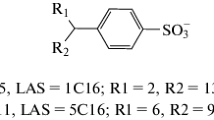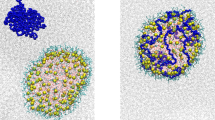Abstract
In this research, we used molecular dynamics simulation to study the transformation of a mixture containing oil, water, and potassium perfluorooctanesulfonate (KPFOS) from a “disordered” state to an “aggregated” state. During the simulation, we observed that the PFOS− molecules spontaneously migrated to the interface between the oil and water phases. The hydrophilic sulfonate groups were oriented toward the water phase, while the lipophilic fluorocarbon chains were oriented toward the oil phase. By analyzing the number density and charge density distribution, we found that PFOS− and K+ ions predominantly accumulated at the oil–water interface, with some K+ ions dispersed within the solution. Moreover, PFOS− formed a stable monomolecular film at the interface, creating a distinct “transition region” with a specific thickness. The mean square displacement (MSD) results indicated that self-assembled micelles composed of PFOS−-facilitated efficient migration of oil molecules within the system, displaying robust migration abilities. Further analysis of the radial distribution function revealed a high probability of K+ ions being found near the oxygen atoms in PFOS− due to charge attraction. Separating K+ ions from PFOS− at the interface required overcoming very strong interaction forces, which limited their migration. Weak van der Waals interactions were observed between the fluorocarbon chains and toluene, while hydrogen bonding interactions occurred between the sulfonate groups and water molecules, as identified through independent gradient model based on Hirshfeld partition analysis. These findings shed light on the complex kinetic processes governing the behavior of oil–water-KPFOS mixtures, providing valuable insights for future studies in this field.







Similar content being viewed by others
Availability of data and materials
All data generated or analyzed during this study are included in this published article.
References
Liu SY, Xiong SC, Weng DW, Song P, Chen R, He Y, Liu XW, Chu SS (2021) Study on deliverability evaluation of staged fractured horizontal wells in tight oil reservoirs. Energies 14(18):1–21
Lei Q, Yun XU, Cai B, Guan B, Wang X, BI GQ, Li H, Li S, Ding B, Fu HF (2022) Progress and prospects of horizontal well fracturing technology for shale oil and gas reservoirs. Pet Explor Dev 49(1):166–172
Cheng SY, Zhang M, Chen ZW, Wu BS (2022) Numerical study of simultaneous growth of multiple hydraulic fractures from a horizontal wellbore combining dual boundary element method and finite volume method. Eng Anal Boundary Elem 139:278–292
Wang ZP, Ge ZL, Li RH, Zhou Z, Hou YD, Zhang H (2022) Coupling effect of temperature, gas, and viscoelastic surfactant fracturing fluid on the chemical structure of deep coal: an experimental study. Energy Fuels 36(7):3468–3480
Ishii M, Murata S, Ishitsuka K, Lin W (2022) Stability of novel cellulose-nanofiber-containing foam as environmentally friendly fracturing fluid. J Petrol Sci Eng 208:2–10
Sun JS, Lei SF, Bai YR, Lyu KH, Cheng RC, Hao HJ, Liu F (2023) Research progress and application prospect of functional adhesive materials in the field of oil and gas drilling and production. Pet Explor Dev 50(1):202–209
Lp Fu, Liao KL, Ge JJ, Huang WQ, Chen LF, Sun XH, Zhang SF (2020) Study on the damage and control method of fracturing fluid to tight reservoir matrix. J Nat Gas Sci Eng 82:103464
Zhang YD, Wu WG, Jing XW, Feng LH (2022) Performance evaluation and field application of variable viscosity fracturing fluid system for tight gas reservoir. Chemical Engineering of Oil & Gas 51(1):73–77
Wu Y, Cheng L, Huang S, Fang S, Killough, JE, Jia P, Wang S (2021) A transient two-phase flow model for production prediction of tight gas wells with fracturing fluid-induced formation damage. J Pet Sci Eng 199(1)
Guo WB, Guo MJ, Tan Y, Bai E, Zhao GB (2019) Sustainable development of resources and the environment: mining-induced eco-geological environmental damage and mitigation measures—a case study in the Henan coal mining area. China Sustainability 11(16):1–34
Aminnaji M, Fazeli H, Bahramian A, Gerami S, Ghojavand H (2015) Wettability alteration of reservoir rocks from liquid wetting to gas wetting using nanofluid. Transp Porous Media 109(1):201–216
Lyu SF, Chen XJ, Shah SM, Wu XM (2019) Experimental study of influence of natural surfactant soybean phospholipid on wettability of high-rank coal. Fuel 239:1–12
Li BB, Zhu WY, Ma QP, Li H, Kong DB, Song ZY (2020) Pore-scale visual investigation on the spontaneous imbibition of surfactant solution in oil-wet capillary tubes. Energy Sources A: Recovery Util Environ Eff 44(2):3395–3405
Wang L, Yao Y, Wang K, Adenutsi CD, Zhao G, Lai F (2022) Data-driven multi-objective optimization design method for shale gas fracturing parameters. J Nat Gas Sci Eng 99:104420
Shi HQ, Ding L, Ding YQ, Liu XR, Li XL, Ming XL (2013) The research of the supramolecular surfactant fracturing fluid system and its preliminary application in Sulige. Gas Field Science Technology and Engineering 13(15):4352–4355
Shibaev A, Osiptsov A, Philippova O (2021) Novel trends in the development of surfactant-based hydraulic fracturing fluids: a review. Gels 7(4):258
Kuchin V, Dvoynikov M, Nutskova M (2020) Isolation through a viscoelastic surfactant of a fracable hydrocarbon-containing formation. J Phys: Conf Ser 1478:1–8
Harris PC, Pippin PM (2000) High-rate foam fracturing: fluid friction and perforation erosion. SPE Prod Facil 15(01):27–32
Xu Y, Tang YF, Li W, Liu YQ, Jing XW (2019) Research on a new type of cleanup additive based on degradable gemini fluorocarbon surfactant. Chemical Engineering of Oil & Gas 48(5):62–65
Jin J, Wang Y, Nguyen T, Bai NJ, Ding WD, Bao M (2019) The morphology and surface-chemistry of gas-wetting nanoparticles and its effect on the liquid menisci in porous media. Ind Eng Chem Res 58(16):6747–6755
Haghighi OM, Zargar G, Manshad AK, Ali M, Takassi MA, Ali JA, Keshavarz A (2020) Effect of environment-friendly non-ionic surfactant on interfacial tension reduction and wettability alteration; implications for enhanced oil recovery. Energies 13(15):1–18
Penny GS, Conway MW, Briscoe JE (1983) Enhanced load water-recovery technique improves stimulation results. Soc.pet.eng.aime Pap
Lucassen-Reynders EH (1982) Surface interactions in mixed surfactant systems. J Colloid Interface Sci 85(1):178–186
Zhang Y, Li D, Wu L, Zhou L, Du YN, Wang M, Li Y (2016) An intensive dispersion and synchronous assembly of single-walled carbon nanotubes in surfactant-oil-water association system. Phys Chem Chem Phys 18(16):10947–10953
Pandey P, Shin K, Jang AR, Seo MK, Hong WK, Sohn JI (2021) Highly sensitive multiplex-detection of surface-enhanced raman scattering via self-assembly arrays of porous AuAg nanoparticles with built-in nanogaps. J Alloy Compd 888:161504
Meng R, Wang C, Jin J, Wang R, Deng L (2022) Self-assembly of hydrophobically associating amphiphilic polymer with surfactant and its effect on nanoemulsion. Colloids Surf A 642:128599–128604
Han LJ, Zhong BY, Chen H, Luo PY (2012) Self-Assembly of hydrophobically associating polyacrylamide and gemini surfactant. Acta Phys Chim Sin 28(6):1405–1410
Tao C, Qing C, Li F (2010) Classic force field for predicting surface tension and interfacial properties of sodium dodecyl sulfate. J Phys Chem B 114(43):13736–13744
Tarek M, Tobias DJ, Klein ML (1995) Molecular dynamics simulation of tetradecyltrimethylammonium bromide monolayers at the air/water interface. J Phys Chem 99(5):1393–1402
Miller CA, Abbott NL, De Pablo JJ (2009) Surface activity of amphiphilic helical beta-peptides from molecular dynamics simulation. Langmuir the Acs Journal of Surfaces & Colloids 25(5):2811–2823
Yan H, Yuan SL, Xu GY, Liu CB (2009) Effect of Ca2+ and Mg2+ ions on surfactant solutions investigated by molecular dynamics simulation. Petrochem Technol 26(13):10448–10459
Li ZQ, Guo XL, Wang HY, Li QH, Liu CB (2009) Molecular dynamics simulation of anionic surfactant aggregation at the oil/water interface. Acta Physico Chimica Sinica 25(1):6–12
Chanda J, Bandyopadhyay S. Molecular dynamics study of a surfactant monolayer adsorbed at the air/water interface. J Chem Theory Comput 1(5):963–971
Shi Y, Xu K, Weng D, Lu YJ, Qin S, Dai NN, Li Y, Lan J (2023) Temperature resistance mechanism of modified partially hydrolyzed polyacrylamide based on molecular dynamics simulation. Chemical Engineering of Oil & Gas 52(03):76–86
Van BAR, Berendsen HJC (1994) Molecular dynamics simulations of carbohydrate-based surfactants in surfactant/water/oil systems. Langmuir 10(6):1703–1713
Neese F, Wennmohs F, Becker U, Riplinger C (2020) The ORCA quantum chemistry program package. J Chem Phys 152(22):224108
Neese F (2012) The ORCA program system. WIREs Computational Molecular Science 2(1):73–78
Brandenburg JG, Bannwarth C, Hansen A, Grimme S (2018) B97–3c: A revised low-cost variant of the B97-D density functional method. J Chem Phys 148(6):64104
Jing XW, Luo Q, Cui XF, Wang QJ, Liu YQ, Fu ZY (2022) Molecular dynamics simulation of CO2 hydrate growth in salt water. J Mol Liq 366:120237–120246
Bayly CI, Cieplak P, Cornell W, Kollman PA (1993) A well-behaved electrostatic potential based method using charge restraints for deriving atomic charges: the RESP model. J Phys Chem 97(40):10269–10280
Lu T, Chen FW (2012) Multiwfn: a multifunctional wavefunction analyzer. J Comput Chem 33(5):580–592
Leandro M, Ricardo A, Ernesto G, Martínez JM (2009) PACKMOL: a package for building initial configurations for molecular dynamics simulations. J Comput Chem 30(13):2157–2164
Izadi S, Onufriev AV (2016) Accuracy limit of rigid 3-point water models. J Chem Phys 145(7):74501
Abraham MJ, Murtola T, Schulz R, Páll S, Smith JC, Hess B, Lindahl E (2015) GROMACS: high performance molecular simulations through multi-level parallelism from laptops to supercomputers. SoftwareX 1:19–25
Spoel DVD, Lindahl E, Hess B, Groenhof G, Berendsen HJC (2005) GROMACS: fast, flexible, and free. J Comput Chem 26(16):1701–1718
Wang JM, Wolf RM, Caldwell JW, Kollman PA, Case DA (2004) Development and testing of a general amber force field. J Comput Chem 25(9):1157–1174
Carretero GR, Kevrekidis PG, Kevrekidis IG, Maroudas D, Frantzeskakis DJ (2005) A Parrinello-Rahman approach to vortex lattices. Phys Lett A 341(1):128–134
Giovanni B, Davide D, Michele P (2007) Canonical sampling through velocity rescaling. J Chem Phys 126(1):14101
Darden T, York D, Pedersen L (1993) Particle mesh Ewald: an N⋅log (N) method for Ewald sums in large systems. J Chem Phys 98(12):10089–10092
Humphrey W, Dalke A, Schulten K (1996) VMD: visual molecular dynamics. J Mol Graph 14(1):33–38
Lu T, Chen QX (2022) Independent gradient model based on Hirshfeld partition: a new method for visual study of interactions in chemical systems. J Comput Chem 43(8):539–555
Jing XW, Zhou L, Li ST, Xu Y, Liu Q, Fu ZY (2023) Molecular dynamics simulation of the distribution of potassium perfluorooctanesulfonate in water. Chemical Papers 1–8
Ghatee MH, Fotouhabadi Z, Zolghadr AR, Borousan F, Ghanavati F (2013) Structural and phase behavior studies of pyridine and alkyl pyridine at the interface of oil/water by molecular dynamics simulation. Ind Eng Chem Res 52(37):13384–13392
Paulina M, Bonthuis DJ, Miller R, Schneck E (2021) Ionic surfactants at air/water and oil/water interfaces: a comparison based on molecular dynamics simulations. J Phys Chem B 125(1)
You XF (2020) Modulation and molecular simulation of the wettability of long-flame coal by nonylphenol ethoxylates. Shandong University of Science and Technology
Funding
This paper is supported by the research program of Petrochina Southwest Oil & Gas Field Company (Grant No.20230302–14) and CNPC Exploration and Production Special Standards Committee International Standard Cultivation Project (Special Standard Exploration International 2023–9).
Author information
Authors and Affiliations
Contributions
Rui Jiang: Writing - Original Draft, Investigation. Xianwu Jing: Model building. Lang Zhou: Formal analysis. Zeyin Jiang: Methodology. Xueping Zhang: Writing - Review & Editing, Supervision. All authors commented on previous versions of the manuscript. All authors read and approved the final manuscript.
Corresponding authors
Ethics declarations
Ethical approval
Not applicable.
Competing interests
The authors declare no competing interests.
Additional information
Publisher's Note
Springer Nature remains neutral with regard to jurisdictional claims in published maps and institutional affiliations.
Rights and permissions
Springer Nature or its licensor (e.g. a society or other partner) holds exclusive rights to this article under a publishing agreement with the author(s) or other rightsholder(s); author self-archiving of the accepted manuscript version of this article is solely governed by the terms of such publishing agreement and applicable law.
About this article
Cite this article
Jiang, R., Jing, X., Zhou, L. et al. Molecular dynamics simulation of potassium perfluorooctanesulfonate at the oil/water interface. Struct Chem 35, 897–906 (2024). https://doi.org/10.1007/s11224-023-02242-9
Received:
Accepted:
Published:
Issue Date:
DOI: https://doi.org/10.1007/s11224-023-02242-9




